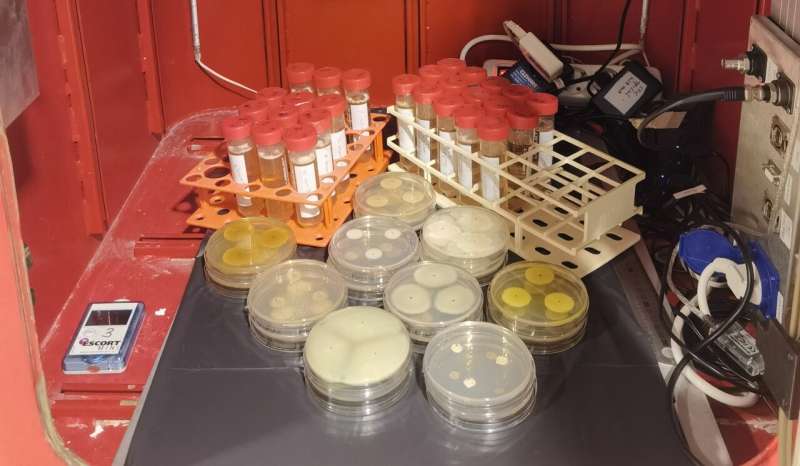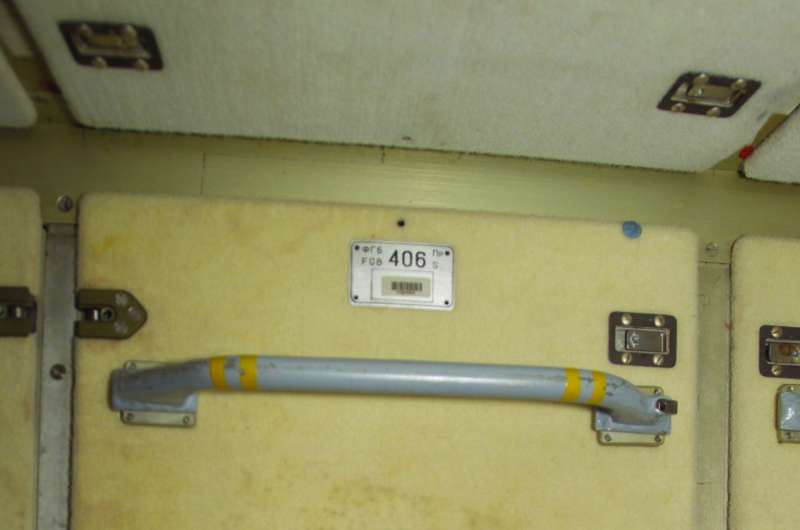This article has been reviewed according to Science X's editorial process and policies. Editors have highlighted the following attributes while ensuring the content's credibility:
fact-checked
trusted source
proofread
Turning up gravity for space fungi study

Fungi in space have been a plot point in Star Trek: Discovery, but they are also a very real problem for astronauts and space stations. United Nations co-sponsored testing by a team from Macau in China subjected fungi to hypergravity with ESA's fast-spinning centrifuge.
A team from the Astrobiology group of the State Key Laboratory of Lunar and Planetary Sciences at the Macau University of Science and Technology of Macau—a special administrative region of China—used ESA's Large Diameter Centrifuge at the ESTEC technical center in the Netherlands to test the growth of fungal colonies under double normal Earth's gravity.
Up until now the Macau team has been making use of 3D clinostats—otherwise known as random positioning machines, which continuously shift their orientation of the gravity vector to simulate microgravity conditions—to test how fungi respond to weightlessness.
Access to the LDC was arranged through HyperGES, part of the Access to Space for All initiative of the United Nations Office of Outer Space Affairs, UNOOSA.
The LDC is an 8 m-diameter four-arm centrifuge that gives researchers access to a range of hypergravity up to 20 times Earth gravity for weeks or months at a time.
At its fastest, the centrifuge rotates at up to 67 revs per minute, with its six gondolas placed at different points along its arms weighing in at 130 kg, and each capable of accommodating 80 kg of payload.
Their two weeks using the LDC enabled the Macau team extended testing into hypergravity conditions, supported by ESA's Life Support & Physical Sciences Instrumentation Laboratory team.
Fungal species were grown until full mature grown was achieved, and then examined to check for genetic or "phenotypic" stress reactions.
Next, one of the selected fungal species underwent a second generation of exposure to hypergravity to see if any stress reactions or alterations were maintained, or whether cumulative effects might be observed. As part of the analysis, selected samples were also analyzed under a scanning electron microscope at ESA's nearby Materials and Electrical Components Laboratory.
"The study of fungi in space is called 'astromycology,' a subset of astrobiology," explains Marta Filipa Simões, leader of this project from Macau University of Science and Technology.
"The ship's engineer in Star Trek: Discovery is an astromycologist, but this is indeed a real field of study and an increasingly important one. Fungi have a long history of making it into space and can have serious impacts once they are there."
The Russian space station Mir experienced fungal contamination as it aged. Portholes became obscured while plastics and metals were corroded, triggering malfunctions in turn—and wider concerns for the station structure.

Prof. Simões adds, "The International Space Station has had its own issues in rooms where crewmembers exercise, with higher humidity leading to fungal contamination on the walls. They have to do a lot of regular cleaning and disinfecting to prevent it.
"In a closed system like the ISS, any time you have the growth of biofilms, which fungi use to stay in place, you can have problems. This can be a serious concern because fungi might also trigger infections or allergic responses in astronauts, whose immune systems are themselves depressed in space. Conversely many fungal species appear to have their growth promoted in microgravity conditions—it is part of our present study to try and better understand why."
Some fungi are always going to make it to space, with hardy fungal spores able to adhere to all sorts of surfaces and tissues, such as the human body. Spacecraft cleanrooms are never pristine in practice; biological surveys show they are home to fungi and other microorganisms.
"We are never going to be able to get rid of fungi entirely as we venture into space, so we need to understand them," says André Antunes, part of the research team of Macau University of Science and Technology.
"In addition, they offer positive opportunities as well as risks. Down on Earth fungi are employed to make food—such as yeast for fermentation—as well as medicines, chemical enzymes for industry as well as metal nanoparticles used in numerous fields.
"For future space settlement they might be harnessed to cover different types of needs,, including recycling, or mining essential minerals out of planetary surfaces. These are seen as essential in helping to reduce costs and ensure sustainability of crewed space exploration."
The next HyperGES team to perform experiments on the LDC comes from Mahidol University, Thailand. They team will investigate how watermeal—the smallest flowering plant on Earth, even smaller than the more familiar duckweed—responds to changing gravity levels to assess its usefulness for space-based life support systems.
Provided by European Space Agency





















